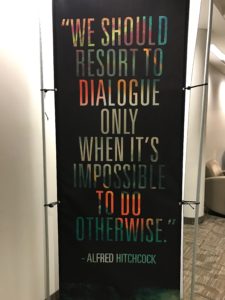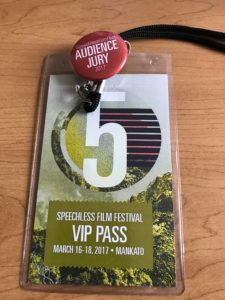Serving as an audience jury member for a film festival makes for quite a different experience from playing octopus at the information booth. I watched 52 films in less than 24 hours during the Speechless Film Festival in Mankato, Minnesota, in mid-March.

Celebrating its fifth year, the Speechless Film Festival focuses on the art of visual storytelling to connect cultures and transcend genres. A banner quoting Alfred Hitchcock conveys this philosophy: “We should resort to dialogue only when it’s impossible to do otherwise.” Many programmed films relied primarily on the visual to convey their messages with little to no spoken words.
The festival maintains strong educational connections with the local liberal arts college, Bethany Lutheran College. Professors from there, Minnesota State University – Mankato, and South Central College served as organizers and judges. Regional arts and media organizations also were represented among the judges and organizers.
The audience jury was a new feature that the festival organizers wanted to try this year. The idea seems a strategic way to gain more participation from the greater community. I was happy to volunteer and help decide the audience award winners.
Though the program included four feature-length films, short films running between one and 20 minutes dominated the schedule. Films came from countries all around the world: Azerbaijan, Brazil, Canada, France, Malaysia, Myanmar, and Switzerland. A couple documentaries snuck in there, but almost all films were fictional narrative.
The programmers grouped films thematically into 17 categories. Some themes followed generic lines such as experimental, animation, and fantasy, while other themes consisted of a key idea such as “journey” or “short and sweet.”

Serving as an audience jury member required that I attend eight sessions. I chose fantasy, animation, experimental, journey, Minnesota loud, Minnesota quiet, animation (family), and art. My favorites were both animation sessions and the journey one.
Animation, both adult and kids, featured strong storytelling, sometimes stronger than some of the live-action pieces. Some narratives, such as Alto El Juego (Walter Tournier) and Hope (Michael Scherrer), offered both harrowing views and, well, hope even within a short runtimes. Some stories appeared simple, such as meeting a girl in Lion Dance (Tim Pattinson and Zheng Kang) or chasing a seashell and the ocean in Au revoir Balthazar (Rafael Sommerhalder).
In the journey category, RM10 (Emir Ezwan) stood out for its focus on a piece of currency’s trip throughout an evening. The currency travels from vendors to sex workers to children to indebted parents to loan collectors to wealthy debt holders, coming full circle in a surprising way at the end.
The festival recognized films with Minnesota connections in the program book, the awards, and the thematic groupings. The program book labeled regional and local films with an “M” within a blue circle to mark “Made in Minnesota.” This category carried two awards of “Best of Show” and “Honorable Mention.”
According to the program, the “Minnesota Loud” category featured “extreme situations, strong aesthetics, or boisterous characters.” The group I watched this category with enjoyed The Car Pool, a short film by Mike Sorenson. Four people car pool to their jobs at a bank, with the usual annoyances of personality quirks, inane chatter, and indecisive coffee ordering. One twist lies in their jobs at the bank: To rob it. The other twist lies in who survives to take the carpool home.
I also appreciated Bobby’s Run Off, directed by John J. Kaiser. Its central plot involves an abused wife accidentally murdering her husband, though the premise suggests that the husband has disappeared. The film handles this delicate subject in an even way, avoiding the salacious spectacle that sometimes results in representing these stories.
The “Minnesota Quiet” category gathered more “contemplative and highly personal stories.” In their collective subtleness, most of these films failed to stand out for me. I suspect their grouping had something to do with that. Directed by Joe Kessler, Half Smile perhaps stood out the most. Forced to clean out a storage unit, a man confronts his past and his losses.
Interestingly enough, none of these films featured strong Minnesota geographical connections within the films themselves, such as particular cities or regions, or strong Minnesota-based plots or people. The connections to the state occurred with the filmmakers and their production locations instead.
In all, the Speechless Film Festival was quite a different experience from the Frozen River Film Festival, and not just in my minor roles in them. The overall festival was much smaller, confined to one venue, and in general its audience skewed younger. Frozen River involved greater swaths of the community than Speechless did. While Frozen River featured multiple titles about Minnesota, Speechless featured films made in –but not necessarily about — Minnesota. Still, though, serving as an audience jury member for Speechless made for an overall cool experience.